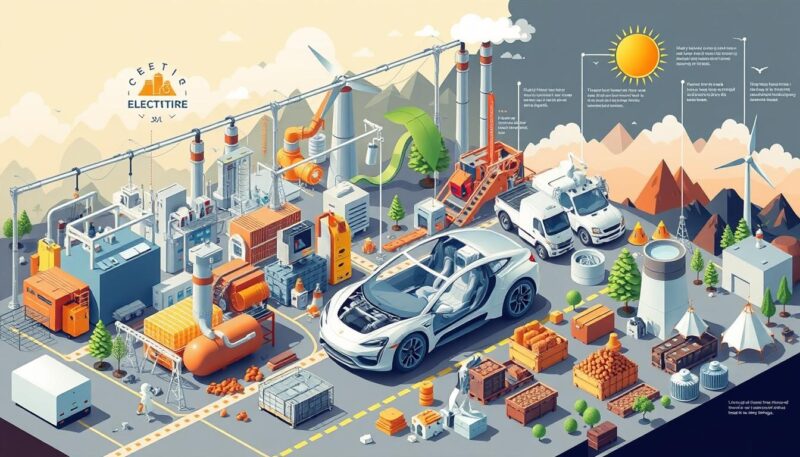As the conversation about climate change intensifies, electric vehicles (EVs) have surged into the spotlight as a potential solution for sustainable transportation. With their promise of reduced emissions and a smaller carbon footprint compared to traditional vehicles, many consumers are left wondering: are electric cars really green? While the environmental benefits of EVs are substantial—such as zero tailpipe emissions and the potential for cleaner energy sources—the reality is more nuanced, requiring an exploration of various factors, including production, materials, and end-of-life disposal.
Globally, enthusiasm for electric vehicles has led countries like Norway, where nearly 80% of new car sales were electric in 2021, and China, with over 3 million passenger EVs sold by 2020, to take significant strides towards a zero-emission future. Furthermore, projections indicate that 50% of new vehicle sales in the U.S. could be zero-emission cars in the coming years. These statistics underline a growing commitment among governments and consumers to transition to cleaner transportation. However, the journey to sustainability with electric vehicles is not without its challenges, warranting a closer look at their entire lifecycle—from lithium extraction and battery production to eventual recycling and disposal.
In this article, we will unpack the intricacies of electric vehicles and their environmental impact, assessing both the benefits they offer and the challenges they present. Understanding these factors will help you make informed decisions about adopting this technology while considering your contribution to sustainability initiatives in your community.
The Rise of Electric Vehicles
The world is witnessing a remarkable surge in electric vehicles (EVs), driven by a collective shift toward electric vehicles sustainability. You may have noticed the growing popularity of EVs as they quickly gain traction in the automotive market. This upward trend reflects a broader commitment to reducing emissions with EVs, supporting environmental initiatives, and fostering cleaner air for our communities.
Popularity and Adoption Rates
Statistics indicate a significant increase in EV sales, with projections suggesting global sales may reach around 17.5 million units in 2024. The transportation sector, a major source of greenhouse gas emissions in the United States, is now embracing electric options to mitigate environmental impact. All-electric vehicles produce zero tailpipe emissions, and plug-in hybrid electric vehicles (PHEVs) offer a similar advantage when operating in all-electric mode. This shift is not merely a trend; it demonstrates a commitment to reducing harmful emissions from transportation.
Government Incentives and Policies
Government incentives for electric vehicles play a crucial role in promoting EV adoption. Tax credits, rebates, and other supportive policies enhance the attractiveness of EVs, encouraging more consumers to make the switch. These incentives coincide with government efforts to reduce reliance on fossil fuels and improve air quality. By fostering an environment conducive to EV growth, policymakers are actively contributing to a sustainable future.
Major Automakers’ Commitments to EVs
Key players in the automotive industry are making significant strides in committing to electric vehicles. Major automakers’ commitments to EVs are evident as companies like General Motors and Volvo have set ambitious targets to transition to all-electric lineups by 2035 and 2030, respectively. Their initiatives align with public demand for sustainable transportation options and highlight the industry’s dedication to reducing emissions with EVs. This collective action from manufacturers signifies a promising direction for the future of transportation.
Electric Vehicles and Their Environmental Impact
Electric vehicles play a crucial role in addressing environmental concerns, notably in reducing air pollution and greenhouse gas emissions. Their ability to operate with zero tailpipe emissions marks a significant improvement over conventional vehicles, thereby enhancing urban air quality.
Zero Tailpipe Emissions and Air Quality Improvements
When utilizing electricity as their sole power source, all-electric vehicles and plug-in hybrid electric vehicles (PHEVs) produce zero tailpipe emissions, providing a cleaner alternative to traditional gasoline or diesel cars. In contrast, conventional vehicles with internal combustion engines emit harmful pollutants directly from the tailpipe, contributing to severe air quality issues like smog and hazy conditions. Minimizing these direct emissions plays a vital part in tackling climate change challenges.
Efficiency in Energy Conversion Compared to Traditional Vehicles
The efficiency of electric vehicles extends the benefits of their zero emissions. Electric motors can convert over 77% of electrical energy into movement, surpassing the 12-30% efficiency seen in internal combustion engines. This higher efficiency allows electric vehicles to operate with a lower EV carbon footprint, thus enhancing their long-term EV environmental impact. Even considering the energy required for manufacturing and disposal, electric vehicles generally outperform traditional vehicles in emissions reductions.
Electricity Source and Its Role in EV Environmental Impact
The environmental impact of electric vehicles directly correlates with the electricity source used for charging. While regions utilizing low-polluting energy sources, such as wind or solar power, highlight the full benefits of EVs, those relying on coal can significantly diminish the overall life cycle emissions advantages. All-electric vehicles can still encounter challenges if charged from higher-emissions electricity grids, stressing the importance of continued efforts to clean up energy sources. To optimize the electric vehicles and climate change benefits, it is essential to transition toward greener energy grids.

| Vehicle Type | Tailpipe Emissions | Energy Conversion Efficiency | Life Cycle Emissions |
|---|---|---|---|
| All-electric vehicles | Zero | 77%+ | Depends on electricity source |
| PHEVs (all-electric mode) | Zero | Similar to electric vehicles | Depends on electricity source |
| Conventional vehicles | Yes | 12-30% | Higher than EVs |
Challenges and Concerns Related to Electric Vehicles
Electric vehicles represent a promising step towards sustainability, yet they are not devoid of challenges. Addressing key concerns surrounding their production and lifespan is essential to ensuring their role in an eco-friendly future. Here are some of the main issues impacting the EV industry today.
The Carbon Footprint of EV Production
The production process of electric vehicles contributes significantly to their overall environmental impact. The EV production footprint includes the extraction and processing of materials like lithium, cobalt, and nickel. Manufacturing an 80 kWh lithium-ion battery for a Tesla Model 3 releases between 2.5 and 16 metric tons of CO2. Environmental impact studies on EVs have shown that, surprisingly, the production phase can have a higher environmental impact compared to traditional internal combustion engine vehicles, primarily due to battery manufacturing. This includes substantial emissions that often go overlooked when considering the benefits of driving electric.
Environmental Impact of Battery Disposal and Recycling
As electric vehicles gain popularity, so does the pressing issue of battery recycling and disposal. By 2025, it is expected that over 1.3 million tons of EV batteries will exit service, posing serious risks if not properly managed. Improper disposal can lead to contamination from toxic heavy metals, severely affecting both ecosystems and public health. On a positive note, effective recycling could potentially supply significant quantities of essential minerals, such as cobalt and lithium, reducing the need for new mining activities. Recycling end-of-life EV batteries could meet up to 60% of global cobalt needs by 2040, highlighting the potential for sustainable practices within the industry.
Ethical Considerations in Material Sourcing
Ethical considerations in EV manufacturing are crucial, particularly regarding material sourcing. Regions rich in lithium, such as Argentina, Chile, and Bolivia, face scrutiny over the impact of mining operations on local communities and ecosystems. Labor practices in the Democratic Republic of Congo, a primary source of cobalt, further spotlight concerns about worker safety and human rights. It is essential for the EV industry to promote ethical sourcing and sustainable practices to enhance transparency throughout the production chain, making sure that environmental and social responsibilities are upheld.

Conclusion
As the popularity of electric vehicles (EVs) surges, it’s vital to evaluate their sustainability and overall environmental impact. The rapid increase in EV adoption, with sales nearly doubling in just one year, signifies a strong consumer interest in cleaner transportation options. However, while electric vehicles boast zero tailpipe emissions, the answer to whether they are truly the solution for green transport lies in their life cycle—from production methods to electricity sources and end-of-life battery management.
Transitioning to electric vehicles can lead to significant environmental benefits, such as reduced greenhouse gas emissions and improved air quality. For instance, newly registered EVs in Europe report emissions that are 69% lower than their gasoline counterparts. Additionally, the growing emphasis on renewable energy can further enhance the long-term environmental impact of EVs. Such transformations are necessary to meet lofty sustainability goals, like the U.S. government’s aim for half of all vehicle sales to comprise zero-emission vehicles by 2030.
Nevertheless, challenges regarding the carbon footprint of EV production, ethical material sourcing, and battery disposal remain prominent. A balanced approach is crucial for ensuring that electric vehicles contribute positively to our planet. By prioritizing cleaner energy generation, responsible manufacturing practices, and recycling initiatives, there’s a pathway forward. Ultimately, driving collective action among consumers, policymakers, and automakers will be essential to realize the full potential of electric vehicles as a cornerstone for a sustainable future in transportation.

